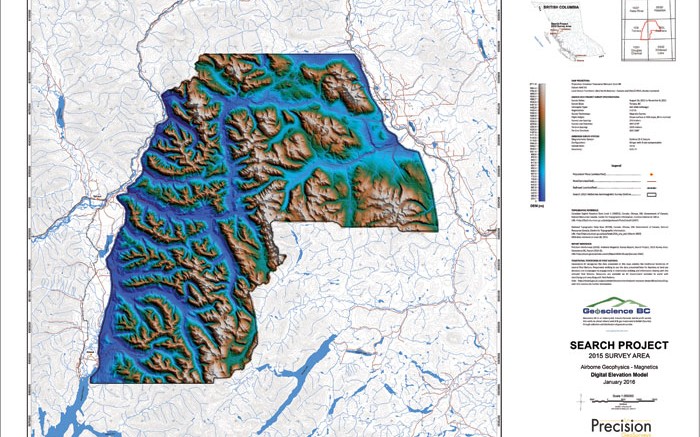VANCOUVER — Bruce Madu, vice-president of minerals and mining for Geoscience BC, has already lined up interesting targets from the latest airborne magnetic survey the organization flew last year over west-central B.C., but he’s going to leave it to explorers to find the paydirt.
Geoscience BC revealed the survey results at a press conference on Jan. 26 at the Mineral Exploration Roundup convention in Vancouver, and Madu said the data will help guide explorers into a new frontier of mineral exploration for the province.
“Finding mineral deposits is a metaphorical hunt for a needle in a haystack,” he said. “With vast tracks of underexplored terrain, knowing where to start is a major challenge — there are endless haystacks. Good geoscience helps explorers narrow their focus and get into the right places to make discoveries.”
Highlights of the high-definition survey were displayed beside the presenters as a smattering of bright pinks and blues, which geoscientists can interpret as the many geological structures and rock types that may be of economic interest.
Madu says that the $2.4-million survey — which was flown at 250-metre line spacing over 6,700 sq. km through Kitimat, Terrace and Smithers — was a much-needed makeover for the province.
“The last survey over this area was completed in the 1960s and spaced at 2 km lines,” he said. “It’s a bit like when you traded in your old television, bought your first flat screen and watched your first hockey game. Suddenly you can see the players and see the actions without needing that red dot along the hockey puck.”
The data is free for the public to interpret, Madu said, and can be downloaded or viewed using Geoscience BC’s earth science viewer, which includes access to other mineral tenures, mineral occurrences, geology and chemistry.
B.C.’s Minister of Energy & Mines Bill Bennett said during the press conference that ever since Geoscience BC was established in 2005, the non-profit organization — jointly funded by the province and industry — has delivered information that hasn’t been seen anywhere else in the country.
“If you look at the work Geoscience BC has done over the years, you can track the investment it’s created, certainly through online staking, but beyond that to identification of deposits and project development,” Bennett said. “You and I may only see bright colours, but there are people who see something much more … and that will fuel their decision to register a claim and drill holes that can add up to millions of dollars in expenses.”
He added that in 2001, B.C. accounted for 6% of the exploration dollars spent in Canada under a Liberal provincial government, and since then, with the pro-business Liberals retaining power, it has grown to 21% — accounting for $338 million spent in 2014.
Although lower numbers are expected in 2015 considering the economic downturn, Bennett said that B.C. needs to maintain its share of Canadian investment.
“The most important thing is how we’re doing in the context of Canada,” he said. “I suspect our numbers are down, but as long as we maintain or improve our share of Canadian investment that means the province is competing effectively.”
Geoscience BC revealed more details of its next proposed survey for 2016, which will link data collected from the 2015 survey to other data sets the organization has generated.
“This new survey is potentially the largest one ever done by us,” Madu said. “It will contribute to the mosaic of geophysics, geology and chemistry data sets we’ve collected, with few equals in the world in terms of scale and public accessibility.”


Be the first to comment on "Geoscience BC tables mag survey of central BC for explorers"